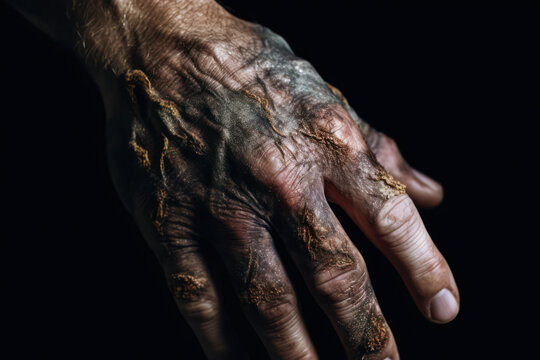Gangrene is a serious medical condition in which body tissue dies due to a lack of blood flow or a severe bacterial infection. This condition often affects extremities such as toes, fingers, and limbs but can also occur in muscles and internal organs. If not treated promptly, tissue death associated with gangrene can lead to significant health complications, including severe infections and the need for amputation.
Understanding the different types of gangrene is crucial for effective diagnosis and treatment. Awareness of these differences can lead to quicker identification and intervention, reducing the risk of severe complications and improving patient outcomes. Recognizing the specific characteristics of each type helps tailor appropriate medical responses and preventive measures.
Types of Gangrene
Dry Gangrene
Causes and Risk Factors
Dry gangrene typically occurs when blood flow to a specific area of the body is reduced or completely halted, often as a result of chronic conditions such as diabetes, arteriosclerosis, or peripheral artery disease. Other risk factors can exacerbate poor circulation.
Symptoms and Identification
Dry gangrene presents with dry and shriveled skin, often dark brown to purplish-blue or black. The affected area may feel cold and numb and is typically not associated with infection. This type of gangrene progresses slowly and can lead to auto-amputation, where the dead tissue eventually falls off.
Wet Gangrene
Causes and Risk Factors
Wet gangrene occurs when an area of the body becomes infected with bacteria following an injury, surgical wound, or ulcer. The presence of infection accelerates tissue death due to the release of toxins by bacteria, making this type of gangrene particularly dangerous. Individuals with diabetes, immune system deficiencies, and those who have had severe burns or injuries are at a higher risk.
Symptoms and Identification
Wet gangrene is characterized by swollen and blistered tissue that appears wet and may ooze fluid. The affected area is usually painful and emits a foul smell. The skin may change color rapidly, from red to black. Because of the fast progression and risk of sepsis, wet gangrene requires immediate medical intervention.
Gas Gangrene
Causes and Risk Factors
Gas gangrene, or clostridial myonecrosis, is caused by infection from Clostridium bacteria, which can enter the body through wounds. These bacteria thrive in low-oxygen environments and release toxins that cause tissue death. Risk factors include traumatic injuries, surgical wounds, and compromised immune systems.
Symptoms and Identification
Gas gangrene is marked by severe pain, swelling, and pale skin that quickly turns gray or purplish-red. The infected area may produce gas, causing a crackling sensation under the skin due to the accumulation of gas bubbles. A foul-smelling discharge may also be present. This type of gangrene spreads rapidly and can be fatal without prompt treatment.
Fournier's Gangrene
Causes and Risk Factors
Fournier's gangrene is a type of necrotizing fasciitis that affects the genital, perineal, or perianal regions. It is usually caused by polymicrobial infections, involving both aerobic and anaerobic bacteria. Conditions that increase risk include diabetes, chronic alcohol abuse, immunosuppression, and recent urogenital surgery.
Symptoms and Identification
Symptoms of Fournier's gangrene include sudden, intense pain and swelling in the genital or perineal area, redness, and tenderness. The skin may become discolored, and subcutaneous gas formation may lead to crepitus. The condition progresses rapidly, often leading to systemic symptoms such as fever and shock.
Meleney’s Gangrene
Causes and Risk Factors
Meleney’s gangrene, also known as progressive bacterial synergistic gangrene, is a rapidly advancing and life-threatening infection of the subcutaneous tissue and skin of the abdomen. It is characterized by persistent necrosis and involves symbiotic organisms with distinct cultural characteristics.
Symptoms and Identification
One of the key identifying symptoms of Meleney’s gangrene is the presence of extremely painful lesions, typically appearing in the second week after surgery or minor trauma. These ulcers, located at the center of the lesion, are usually covered by a black eschar and surrounded by a gangrenous margin. As with other types of gangrene, rapid progression can lead to systemic infection and necessitate urgent medical attention.
Understanding the distinct causes, risk factors, and symptoms associated with different types of gangrene is crucial for timely diagnosis and treatment. Each type presents unique challenges, and recognizing these can help manage the condition effectively and prevent severe complications.
Risks of Gangrene
Complications from Untreated Gangrene
One of the most severe risks of untreated gangrene is the progression of the infection to other tissues and organs. Gangrene, in any of its forms, results from the death of tissue due to a lack of blood flow or severe infection. If left untreated, the necrotic tissue can serve as a breeding ground for bacteria, quickly spreading and leading to more extensive tissue damage. This can result in the spread of the necrotic process to adjacent areas, further complicating treatment and recovery. The body’s inflammatory response to the necrotic tissue can also lead to systemic inflammation, complicating the patient’s overall health.
Systemic Infections and Sepsis
A critical risk associated with gangrene is the potential for systemic infections, including sepsis. Sepsis is a life-threatening condition caused by the body's extreme response to infection, which can lead to tissue damage, organ failure, and death. When gangrene is left untreated, bacteria and toxins from the necrotic tissue can enter the bloodstream, leading to septicemia. Sepsis requires immediate medical attention and aggressive treatment with antibiotics and other supportive measures. The progression to sepsis significantly increases the risk of mortality and long-term health complications.
Amputation and Loss of Function
One of the most drastic and immediate risks of gangrene is the need for amputation. When gangrene affects a limb or extremity, and the tissue death is extensive, amputation may be the only viable option to prevent the spread of infection and save the patient’s life. Amputation can lead to a significant loss of function and mobility, impacting the patient's ability to perform daily activities and reducing their quality of life. Rehabilitation and prosthetics may help, but the physical and psychological impacts of amputation are profound.
Impact on Quality of Life
Gangrene can have a severe impact on a patient’s quality of life. Beyond the immediate physical consequences, such as pain and loss of function, the psychological and social ramifications are considerable. Patients may experience chronic pain and require long-term medical care, including wound management, physical therapy, and possibly further surgeries. The emotional toll of dealing with a severe illness, potential amputations, and the loss of independence can lead to depression and anxiety. Socially, patients may face challenges in returning to work or participating in community activities, which can lead to feelings of isolation and decreased self-esteem. Ensuring comprehensive care, including psychological support, is essential to address the multifaceted impact of gangrene on patients' lives.
Treatment Options for Gangrene
Medical Interventions
- Often requires medical management to improve blood flow to the affected area. This can include anticoagulants to prevent blood clots and vasodilators to widen blood vessels. In addition, managing underlying conditions such as diabetes or atherosclerosis is crucial.
- Intravenous antibiotics are administered immediately to combat the bacterial infection. Intravenous fluids and medications to support blood pressure and organ function may also be necessary.
- Hyperbaric oxygen therapy, which involves breathing pure oxygen in a pressurized room, can help increase oxygen supply to the affected tissues and enhance healing.
Surgical Options
- Vascular surgery, such as bypass surgery or angioplasty, may be performed to restore adequate blood flow to the affected area and prevent recurrence.
- Surgical debridement is essential to remove necrotic and infected tissue. In many cases, multiple surgeries may be required to ensure all dead tissue is removed.
- Surgical intervention may include vacuum-assisted closure (VAC) therapy to help close wounds and promote healing.
- In advanced cases, amputation may be necessary to save the patient's life. After controlling the infection, reconstructive surgery may be needed to restore function and appearance.
Prevention of Gangrene
Preventing gangrene involves a multifaceted approach aimed at reducing risk factors and maintaining overall health. Individuals can significantly lower their chances of developing different types of gangrene by focusing on proper hygiene, managing chronic conditions, early detection and treatment of infections, and making essential lifestyle modifications.
Managing Chronic Conditions
Proper management of chronic conditions such as diabetes, peripheral artery disease (PAD), and hypertension is vital in preventing gangrene. Maintaining controlled blood sugar levels through a balanced diet, regular exercise, and medication adherence can prevent complications like neuropathy and poor circulation, which are significant risk factors for diabetic gangrene. Regular check-ups with healthcare providers to monitor and manage PAD and other cardiovascular conditions can help ensure adequate blood flow to the extremities, reducing the risk of developing gangrene. Additionally, patients should work closely with their healthcare providers to manage and treat any other underlying conditions that could predispose them to gangrene.
Early Detection and Treatment of Infections
Prompt identification and treatment of infections are critical to preventing the progression of gangrene. Individuals should seek medical attention for any signs of infection, such as redness, swelling, warmth, pain, or discharge from a wound. Early intervention with appropriate antibiotics or antifungal medications can halt the spread of infection and prevent tissue death. Regular monitoring of wounds, especially in at-risk populations, can catch infections early and allow for immediate treatment. Healthcare professionals should also educate patients about the importance of early detection and provide guidelines on when to seek medical help.
Lifestyle Modifications
Smoking Cessation
Smoking significantly impairs blood circulation and immune function, increasing the risk of developing gangrene. Quitting smoking can improve overall cardiovascular health, enhance blood flow to the extremities, and reduce the risk of infections. Support programs, nicotine replacement therapies, and counseling can assist individuals in their efforts to quit smoking and improve their long-term health outcomes.
Healthy Diet
A balanced diet rich in fruits, vegetables, lean proteins, and whole grains can help manage chronic conditions like diabetes and PAD, reducing the risk of gangrene. Proper nutrition supports overall immune function and wound healing. Individuals should aim to maintain a healthy weight, as obesity can contribute to poor circulation and increased pressure on the extremities, raising the risk of developing sores and ulcers.
Regular Exercise
Regular physical activity enhances circulation, helps control blood sugar levels, and supports cardiovascular health. Exercises such as walking, swimming, and cycling can improve blood flow to the extremities and reduce the risk of conditions that can lead to gangrene. Individuals should consult their healthcare providers to develop a safe and effective exercise regimen tailored to their health status and capabilities.
Conclusion
Understanding the various types of gangrene—dry, wet, gas, Fournier's, and Meleney's gangrene—is crucial for recognizing their unique causes, symptoms, and treatment options. Prompt medical attention is vital for any type of gangrene, as early intervention can prevent severe complications such as systemic infections, sepsis, and amputation. Proper hygiene, managing chronic conditions, early infection detection, and lifestyle modifications are essential preventive measures. If you suspect gangrene, seek professional healthcare guidance immediately to ensure effective treatment and improve health outcomes.



.webp)

.avif)
